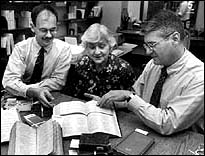![]()
Departments
![]()

|
Week of 26 September 1997 |
Vol. I, No. 5 |
Feature
Article
An STH hymnal collection heads for international databasesby Jim Graves Qui cantat bis orat. "To sing is to pray twice," said St. Augustine of Hippo. His adage suggests the importance of music in Christian worship -- and thereby hints at the importance of a remarkable church-music collection at the School of Theology Library, which scholars throughout the world will soon be able to locate on electronic catalogs.
"Twenty-six percent of the hymnals that we've examined so far don't appear on the OCLC database, which means this collection fills in a lot of gaps for researchers," says Raymond Van De Moortell, the head of technical services for the library. The collection is an amalgamation of hymnal collections do-nated separately by two staunchly Methodist alumni. Charles Nutter (1842-1928) graduated from STH in 1871, the year in which the Boston Theological School merged with Boston University. When not serving as a Methodist preacher, Nutter collected hymnals and wrote both hymns and authoritative books on hymnology. (In 1913, he taught hymnology at BU.) The other donor, Frank Metcalf 1865-1945), an 1886 BU alumnus, worked in the U.S. War Office and, like Nutter, collected hymnals and wrote on hymnol-ogy. "Interestingly, both Nutter and previous owners annotated the end papers of many of the volumes with commentary that sometimes throws light on hymnology," says Myra Siegen-thaler, STH head librarian. Brian Frykenberg, the librarian who is updating the cataloging, says his work to date shows that about 17 percent of the books were printed before 1820. The collection includes such rare works as an Ainsworth Psalter printed in Amsterdam in 1612. According to a notation by Nutter, this text was "what the pilgrim fathers sang" in their worship. Other early titles are the Geneva Psalter, a 1556 French Huguenot psalm book contemporaneous with John Calvin, and a 1578 edition of The Whole Book of Psalmes, compiled for Anglicans by Thomas Sternhold and John Hopkins. Nutter's copy of the Sternhold-Hopkins volume differs from two other OCLC-documented copies of the text in that it contains psalms used in Anglican morning and evening prayer services. Psalters are found often in the collection and individual psalms appear frequently in the hymnals, notes Frykenberg, because "psalms were the first hymns. They have been sung in worship services from the earliest days of Christianity, and before that they were sung in the synagogues. As opposed to sermons and scripture readings," he continues, "hymns represent the part of worship services that congregations perform together." Later hymns in the collection represent many periods, starting with that of St. Ambrose of Milan, the great bishop and hymnographer of the fourth century. Yet while some of the volumes are quite rare, the value of the collection lies less in its cash value than in the variety it presents to scholars studying textual changes occurring in sequential editions of hymnals, comparing hymns used by various denominations, or tracking printers and engravers over a period of years. Congregationalists, Shakers, Unitarians, and many other denominations are represented, but the core of the collection is Methodist and of New England provenance, points out Siegenthaler. But while "hymns in many of these books reflect a revivalist, camp-meeting mood that was especially typical of early Methodism," says Van De Moortell, "taken as a whole the collection helps document the evolution of Christian worship. And because hymns inevitably reflect doctrine, these books show us how people have viewed God." Besides their variety of content, shape, size, the volumes -- in English, Latin, French, and German -- have about them the engaging look, heft, and scent of things that have acquired distinction with age. "I enjoy coming to work every day," says Frykenberg. "I enjoy handling these books."
|
